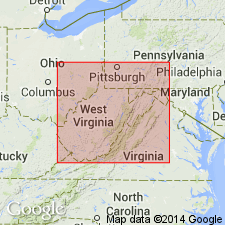
- Usage in publication:
-
- Parrott formation
- Modifications:
-
- Named
- Dominant lithology:
-
- Sandstone
- Siltstone
- AAPG geologic province:
-
- Appalachian basin
Summary:
Named the Parrott formation for Parrott, Pulaski Co., southwestern VA. Used for succession overlying the reddish-brown sandstones of the "Chemung" or Broadford sandstone and underlying "jelly-bean" quartz pebble conglomerates at base of Price formation. Consists chiefly of rusty-weathering sandstones and siltstones many of which contain abundant marine fossils. Thickness is 350 to 600 feet. These beds have been included in Price formation.
Source: GNU records (USGS DDS-6; Reston GNULEX).

- Usage in publication:
-
- Parrott†
- Modifications:
-
- Abandoned
- AAPG geologic province:
-
- Appalachian basin
Summary:
Suggests abandonment of Parrott Formation based on lithologic similarities to Chemung Formation and fact that unit was established based on paleontological grounds.
Source: GNU records (USGS DDS-6; Reston GNULEX).
For more information, please contact Nancy Stamm, Geologic Names Committee Secretary.
Asterisk (*) indicates published by U.S. Geological Survey authors.
"No current usage" (†) implies that a name has been abandoned or has fallen into disuse. Former usage and, if known, replacement name given in parentheses ( ).
Slash (/) indicates name conflicts with nomenclatural guidelines (CSN, 1933; ACSN, 1961, 1970; NACSN, 1983, 2005, 2021). May be explained within brackets ([ ]).

